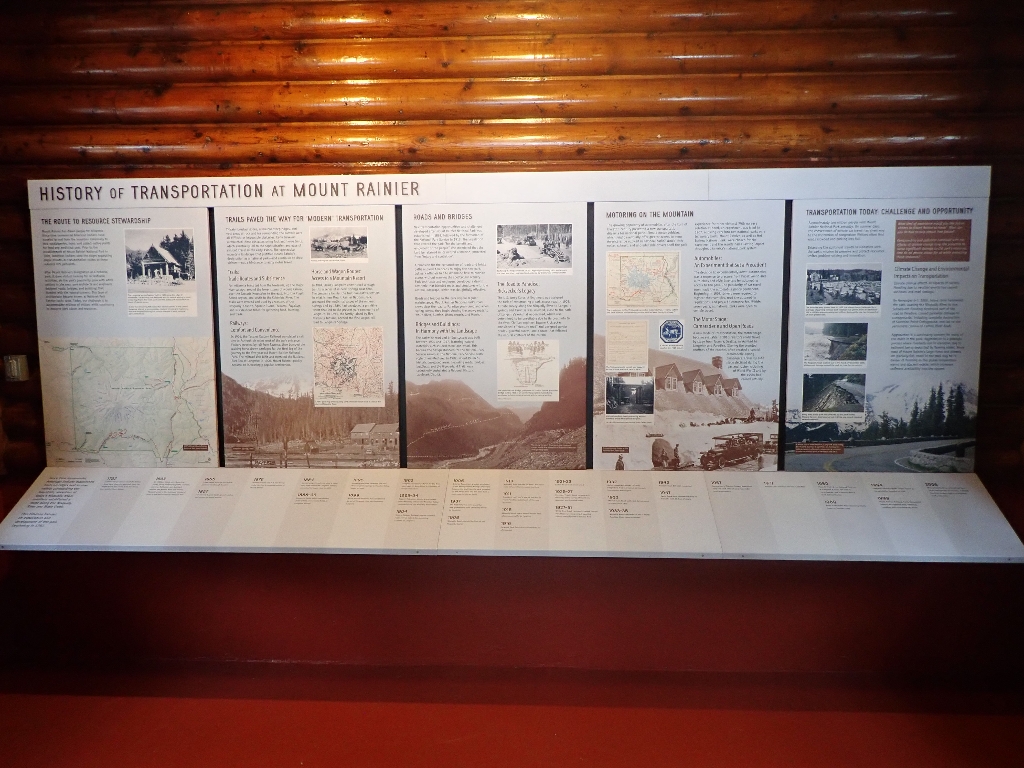
Season: Year-round
Longmire is located in the southwest corner of Mount Rainier National Park and is 6.5 miles (10.5 km) east of the Nisqually Entrance. The Transportation Exhibit is located inside the historic Longmire Service Station, which is next to the National Park Inn. The exhibit is open daily when the Longmire Museum is open. The exhibit panels are attached to the wall across from the door and consist of five panels with a timeline stretching across the bottom of the panels.
History of Transportation at Mount Rainier
Timeline Text
Since time immemorial, American Indians established trails on ridges and in river valleys surrounding the mountain; ancestors of today’s Nisqually tribal members established aroute along the Nisqually River and Skate Creek.This timeline focuses on exploration and development of the park beginning in 1792.
- 1792 - Captain George Vancouver of the British Royal Navy views the mountain from thePuget Sound and names it for his friend, Rear Admiral Peter Rainier
- 1833 - Dr. William Tolmie, on a botanical survey led by indigenous guides Lachalet,Lashima, Nuckalkut, and Quilniash, reaches the Mowich River and Mount Pleasant areas in the northwest corner of what is now Mount Rainier National Park
- 1855 - Tribes ceded lands to the federal government through treaties
- 1857 - Lieutenant August Kautz almost reaches the summit of Mount Rainier
- 1870 - Hazard Stevens and P.B. Van Trump make the first documented ascent of Mount Rainier
- 1884 - James Longmire and crew clear a rough trail from Ashford to Longmire Springs; converted to wagon road in 1893
- 1888-90 - Longmire family builds bathhouses, guest cabins, and a rustic hotel at Longmire Springs
- 1895 - Longmire and crew complete the trail from Longmire Springs to Paradise Valley, begun in 1885
- 1899 - Mount Rainier National Park established by act of Congress; first park boundary is square
- 1903 - Congress appropriates funds for the first park road; US Army Corps of Engineers incharge until 1912
- 1903-04 - Eugene Ricksecker directs a road survey from Nisqually Entrance to Paradise Valley; construction of the Nisqually Road begins
- 1904 - Tacoma Eastern Railroad reaches Ashford; stage service covers the remaining 13 miles to Longmire
- 1906 - Interior Department granted permission to the Mount Rainier Mining Company to improve the trail from the park boundary up the White River and the Inter Fork to their camp in Glacier Basin
- 1907 - The first motorists convoy up the new government road (Nisqually Road) to Longmire
- 1908 - Nisqually Road reaches the foot of the Nisqually Glacier
- 1910 - Nisqually Road reaches Paradise, but autos were not permitted on upper sections
- 1911 - President Taft’s car is one of the first to reach Paradise, pulled part of the way by mules
- 1915 - Nisqually Road opens above Narada Falls, allows auto traffic to Paradise
- 1916 - National Park Service established by act of Congress
- 1921-23 - Carbon River Road constructed
- 1925-27 - Bureau of Public Roads reconstructs Nisqually Road; surveys White River, Westside, and Eastside roads
- 1927-31 - White River Road (previously called Yakima Park Highway) constructed, opening Sunrise development in Yakima Park
- 1932 - Mather Memorial Parkway (SR 410) designated; first road access to the park from eastern Washington
- 1933 - Mowich Lake Road built, but did not open to autos until 1955
- 1933-35 - Westside Road completed as far as North Puyallup River; never extended
- 1940 - Eastside Road (SR 123) completed
- 1947 - Kautz Creek lahar covered the road to Paradise with 28 feet of debris
- 1957 - Completion of Stevens Canyon Road links east and west sides of park; last major road development
- 1977 - Annual park visitation reaches 1,000,000
- 1980 - Plaza in front of the National Park Inn at Longmire is built, the road is reconfigured, and a parking area is built behind the inn
- 1989 - Most of Westside Road closed by debris flows on Tahoma Creek
- 1994 - Longmire Service Station closes; opens as transportation museum in 1998
- 1999 - Mount Rainier National Park’s Centennial; General Management Plan addresses crowding and transportation issues
- 2006 - Widespread flooding at Sunshine Point closes the park for six months. Parkwide flooding triggers repairs of buildings, trails, and roads
Panel 1: The Route to Resource Stewardship
Panel 2: Trails Paved the Way for “Modern” Transportation
Panel 3: Roads and Bridges
Panel 4: Motoring on the Mountain
Panel 5: Transportation Today: Challenge and Opportunity
Is there something we missed for this itinerary?
Itineraries across USA


















































